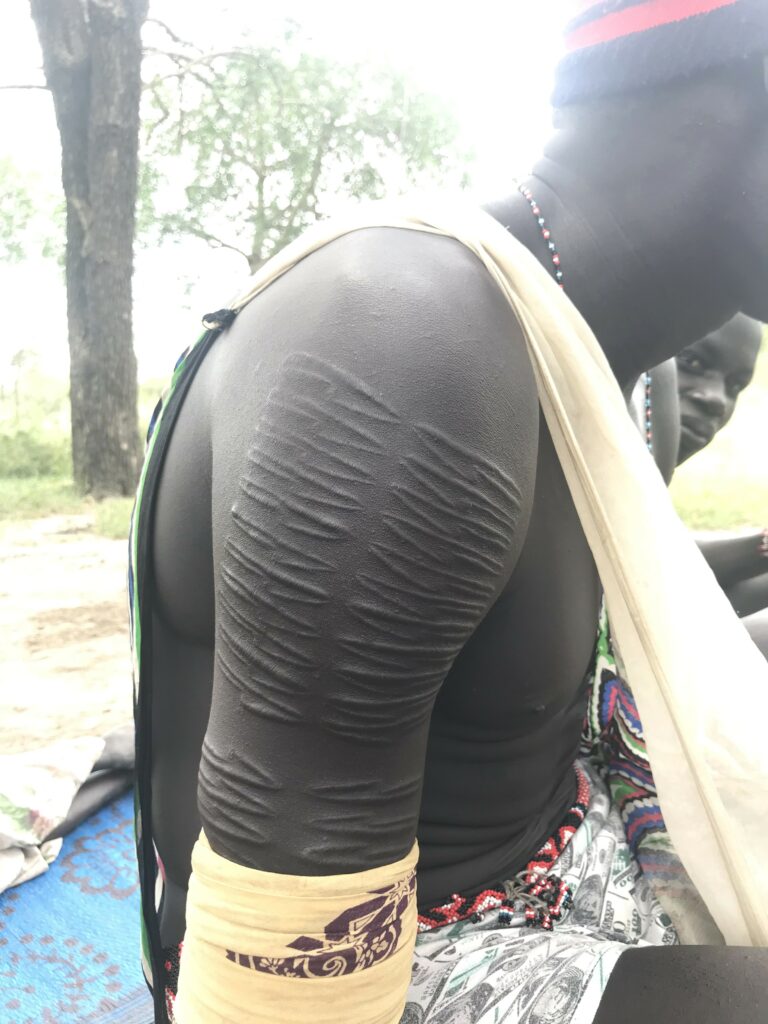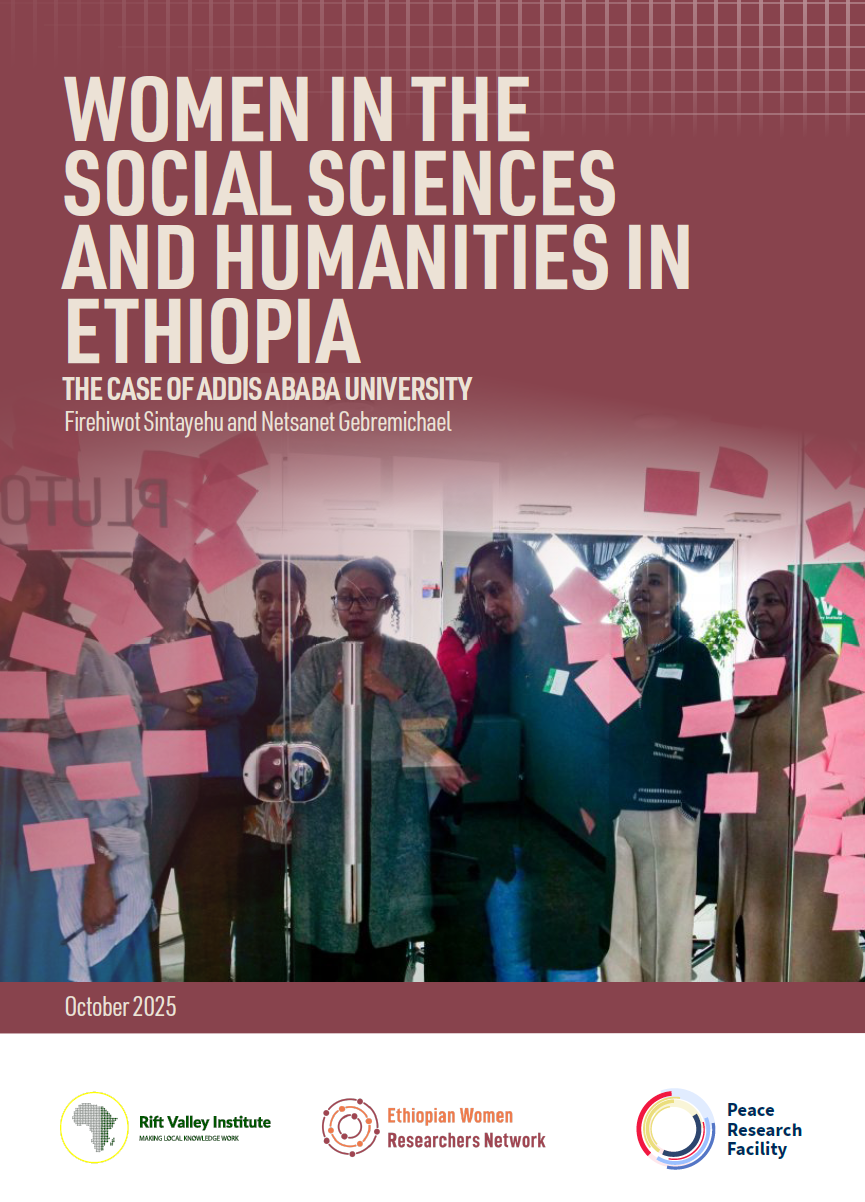This blog post discusses how the Murle social institution of age-sets (sometimes known as generations) has, in recent years, been fragmenting and is becoming increasingly militarized. Body scarification is a valuable lens through which to view these transformations, as well as a way to better understand individual and collective youth identities, hopes and aspirations.
Drawing on material and immaterial cultural expressions, like body scarification or beads, offers a platform to debate issues ranging from identity, hopes and aspirations, to social changes and transformations. These reflections are based on the recent experience of hosting a multi-sited photo exhibition on Murle age-sets and body scarification in early October 2022 in Juba and in Pibor, supported by the Impact and Knowledge Exchange Fund at SOAS (photos 1, 2 and 3). The photos offered a visual journey of how young people from the three youngest Murle age-sets in the Pibor lowlands have, since the early 2000s, been incorporating new symbols of power and modernity into traditional practices of body scarification. Scarification is used to create identifying markers for the age-set and sub-groups in the Murle community.


Age-set systems (buul) have in many parts of East Africa become largely ceremonial. However, in Murle society they remain the most important of the three core interconnected social institutions. Along with clans or chieftaincy drum ships (Alaat o kidoŋo[wa]) and spiritual chiefs, known as red chiefs (alan ci merii), the age-set unites people as a group and shapes the discourses of a distinctive and cohesive community.
Murle age-sets are social groups consisting of men of a similar age interval spanning roughly a 10-year period. They share a common identity and maintain close ties and relations throughout life. Women will belong to their father’s age-set and eventually to their husband’s. For Murle people, the buul is a fundamental lifelong identifier and unifier, and provides individuals with a sense of identity, belonging and certainty, networks of solidarity and protection, support and loyalty across the entire Murle community. Each age-set selects certain token animals or birds based on the qualities they represent, and relate to the colour of those animals or birds represented also by the beads they choose. Across the countryside of Murleland, people proudly expose their age-set identity through the colours of the beads that are worn and by permanently scarifying the age-set symbol on their bodies.
These youth have also creatively appropriated this traditional practice to reflect their place in a global world and aspirations for the socio-economic benefits of modernity. In a world that privileges the verbal and written text, these young people tell their own stories on their own terms through the inscriptions on their bodies. The permanently inscribed designs and images offer insights into how age-sets have been adapting, and fragmenting in light of decades of violent conflict.

The photo exhibition had portraits of some of these young men hailing from the younger age-sets, as well as close-ups of the new iconography they have adopted. These include new designs representing ideals of social and economic development with symbols like the UN acronym, pen lids and water pumps (photos 4, 5 and 6); and symbols of economic status and opportunities such as keys, batteries or wristwatches. It also included references to military power and security reflected through symbols such as AK-47s, ranks and satellite phones (photos 7, 8 and 9) permanently inscribed on the body. Presented alongside direct quotes, we are able to understand how young men and women in the countryside of Pibor are explicitly telling their own individual and collective stories, and making claims on the promises of modernity through powerful, permanent body art.
Photographs 4, 5 and 6 (below): Designs of pen lids, water pump and the UN acronym, from the same man belonging to a nyakeno called ‘Hakimanet’ (Doctors) from Kurenen age-set, Manyumen village, September 2019 (photos by Diana Felix da Costa)



Scarifications are a powerful form of ‘indirect, nonverbal, and extra-linguistic mode of communication’ (in the words of Dwight Conquergood), and a socially situated alternative medium of producing and negotiating knowledge about the world around. But these new designs do not only speak about and to young people’s hopes and expectations. They also reveal how new sub-identities have been forged as a result of the militarization of society that has led to the fragmentation of the age-sets. The new designs represent sub-groups and sub-identities that have emerged within the age-sets.
It is no coincidence that this new trend was started by the age-set known as Bothonya (after the wild duck or mallard), which first emerged around the year 2000 and spread throughout the region over the first half of that decade. As explained by James Aleyi, an intellectual in Pibor town, ‘these young men of Bothonya were born during the SPLA war, they had seen war everywhere since the 1980s.’ Composed of young men who were born and raised throughout the 1980s and 1990s, during Sudan’s violent second civil war, Bothonya age-set were the first to form sub-groups known in Murle language as ken or nyakeno (sing.) (or nyankenet, plural).
These are sub-groups within the same age-set loosely based on age and region that will have their own name, bead arrangement, songs and dance, and particular designs inscribed on the body that reflect their nyakeno name. For instance, a nyakeno that name themselves Tojar, meaning businessman in Arabic, will inscribe designs that youth associate with business people like keys, batteries and mobile phones. Another nyakeno may call themselves Koliyam (after the Murle term for the SPLA) and be represented through designs of AK-47s, army ranks and stars, and satellite phones.
For James, this fragmentation of age-sets could be traced to ‘the adoption of an ideology of an army. It’s the militarization of the age-sets and the adoption of an army system, fragmented and organized as an army.’ It is not just that ‘in an army you have platoons, companies, battalions, brigades and divisions and that nyakenet resemble military structures and organisation,’ in other words, armies are organized hierarchically into progressively smaller units commanded by officers of progressively lower rank. It is also that many of the names of the nyakenet are inspired by the military. Notably, there are nyakenet named Jij (photos 7 and 8) and Koliyam (both after the SPLA – photo 9), Habeesh (after the Ethiopian army) and Suar (after the Cobra Faction armed group).



Photograph 7: Designs of military ranks and glasses representing the nyakeno, Boma August 2013 (Diana Felix da Costa).
Photograph 8: Designs of AK-47s and reedfish, representing the nyakeno and Lanngo age-set respectively, Kong Kong May 2015 (Diana Felix da Costa).
Photograph 9: Young man from Kurenen age-set, nyakeno called Koliyam (SPLA) represented by ‘South Sudan’ inscribed on the body, along with SPLA symbols such as the sign for Division 2 and Division 8. Manyirany, June 2022 (photo by Lauryen Oleyo).
This blog piece cannot go further into how recent histories of violence and conflict in South Sudan have profoundly affected and transformed not just social institutions but also generational relations and the core of the country’s social fabric. What we wish to emphasize is how material expressions of heritage in South Sudan – such as body scarification – are fluid and changing. Young people in Murle society, as elsewhere in the country, are creatively re-shaping and making sense of traditional practices to suit them. They are telling their own individual and collective stories through cultural mediums that make sense to them.
These new designs give nuance, complicate, challenge and disrupt stereotypes of seclusion and isolation, of histories of conflict and of antagonism between neighbours, offering really valuable insights into value systems and admiration towards neighbours that are simplistically assumed to be enemies. They also challenge the idea that these young people are just living on the edges of society, lost and half-forgotten in cattle-camps. Rather, they are highly mobile and move in and out of town, well aware of its opportunities and advantages – from education to health to business opportunities – and are very clearly communicating what is important to them.
Below the two blog authors share their own personal reflections on the importance of this work:
As a researcher engaged in long-term research in Pibor, it strikes me as particularly important to not just recognize and learn from people’s elected means of communication, but also to reflect on and find de-colonial ways to co-produce knowledge about, alongside and with Murle people. The photo exhibition was part of this process, as is the website launched earlier in 2022 on Murle heritage, also intended to showcase and promote Murle culture, keer ci Murlo, and offer an easily accessible space to hold conversations about the latter in South Sudan and beyond.
The idea of the website emerged from discussions with long-time friends and leaders Joseph Lilimoy, an educator, and Helen Lukurynyang, an MP in South Sudan’s National Parliament, and a subsequent consultation process with Murle intellectuals in Pibor, Juba and in the diaspora. The hope is that the website can serve as a multimedia digital archive of Murle tangible and intangible heritage and a platform where different voices can share knowledge and exchange ideas. In the process, it will do its part in reframing understandings about Murle society. Diana Felix da Costa
As an intellectual in my community interested in how my society is transforming, I find it important to have platforms to document and share knowledge about Murle society, such as the website on Murle heritage or the exhibition and panel discussion on age-sets and body scarification. These platforms can be of significant benefit to the community. Murle society is transforming and many cultural norms and systems and their material and immaterial cultural expressions reflect these changes. For instance, our youth have adopted new designs and styles in body scarification that reflect the modern world, like phones and military ranks; these designs were not there when I was growing up. Our cultural dances have also changed and Bothonya age-set and those that have come after have adopted novel styles unique to their age-set animals to differentiate from others, whereas before, Murle age-set dance styles were more standardised. These cultural changes show how young people these days are searching for ways to stand out and distinguish themselves from their elders using culture as a material expression of their identity and place in the world.
I was one of the speakers in the panel discussion organised alongside the photo exhibition and am also involved in the management of the Murle heritage website because I believe negative narratives prevalent about Murle can only be changed through better access to information about Murle history, culture and customs and by having more platforms where Murle people can represent themselves. John Boloch Kumen
This blog post was prepared by Diana Felix da Costa and John Boloch Kumen.




